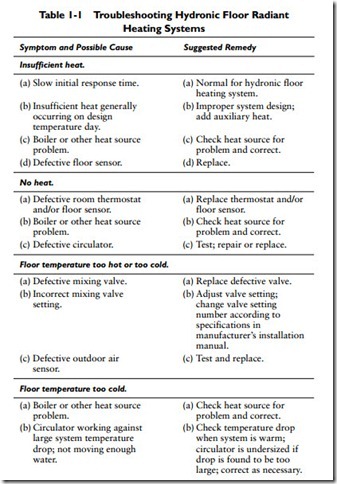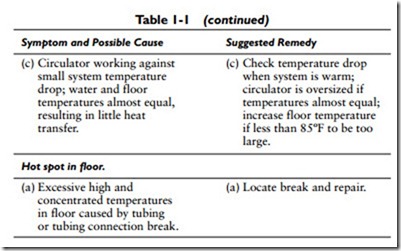Servicing and Maintaining Hydronic Radiant Floor Heating Systems
Hydronic radiant floor heating systems require very little service and maintenance, but this does not mean they should be ignored. The following recommendations apply to all floor heating systems:
• Check the system pressure on a regular basis. An incorrect pressure reading may indicate air trapped in the system. An air pocket or bubble will block the flow of water and cause pressure readings outside the norm.
• Check the system for leakage. If the tubing is attached under the floor to the stud bottoms, access to the tubing or tubing connections to make repairs is relatively easy. If the tubing is embedded in cement above the subfloor, however, locating a leak is more difficult and expensive.
• Check to make sure there is enough water in the system. If not, it may need refilling.
If purging air, repairing leaks, and/or refilling the system with water does not result in maintaining the required pressure in the system, ask for a service call from a certified HVAC technician with experience in hydronic floor radiant heating systems.
Troubleshooting Hydronic Floor Radiant Heating Systems Problems with hydronic floor radiant heating systems (see Table 1-1) will occur in the following areas:
1. Heating appliance (boiler, heat pump, or water heater)
2. Circulator (circulating pump)
3. Automatic controls
4. Tubing
Most of the troubleshooting and repair procedures for the vari- ous components of a hydronic floor radiant heating system have been described in considerable detail in other chapters. Use the vol- ume index to locate those sources of information.
The first step when troubleshooting a radiant floor system is to check the controls. Turn the room thermostat on or off and wait for a few minutes for the system to respond. If the system responds by turning on or off within 2 or 3 minutes, the controls are not the problem.
Check the boiler, heat pump, or water heater for a problem. These appliances and their troubleshooting methods are described in Chapter 15 (“Steam and Hydronic Boilers”) in Volume 1, Chapter 10 (“Heat Pumps”) in Volume 2, and Chapter 4 (“Water Heaters”) in Volume 2, respectively.
Note
Some heating systems have a thermometer installed in the circulation loop. The thermometer displays the temperature of the circulating water. A low fluid temperature displayed while the circulator is operating will indicate a problem with the boiler, heat pump, or water pump.
The troubleshooting and repair of circulators (water-circulating pumps) is covered in Chapter 10 (“Steam and Hydronic Line Controls”) in Volume 2.
Problems requiring repairs or replacements of the manifolds or loops, especially embedded loops in wet installations, require the expertise of HVAC technicians experienced in the installation and maintenance of floor radiant heating systems.
Hydronic Radiant Heating Snow- and Ice-Melting Systems
Radiant systems used to melt snow and ice on driveways, side- walks, and other outdoor surfaces are inexpensive to operate because they are used only when required. They begin to operate at a reduced output mode when the outdoor temperatures drop below a certain preset point and then switch to full operation when rain or snow reaches the surface.
The simplest form of control for snow-melting and ice-melting installations is a remote, manually operated on-off switch. The switch is commonly located inside the garage and operated only when required. Some snow- and ice-melting installations are operated by an automatic control system connected to a thermostat and a heating boiler, heat pump, or water heater.
Because the tubes carrying the heated water are located outdoors beneath the driveway surface, an antifreeze solution such as propylene glycol should be added to protect the system from freezing.

